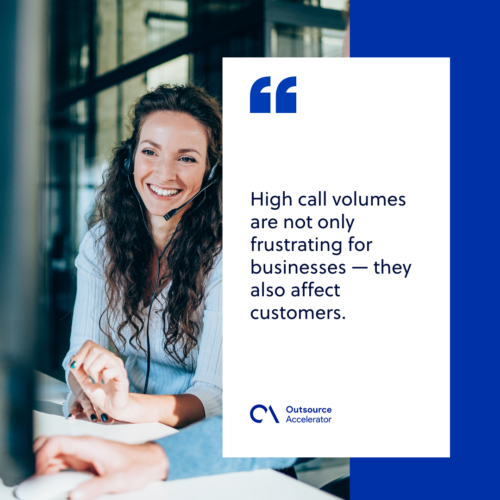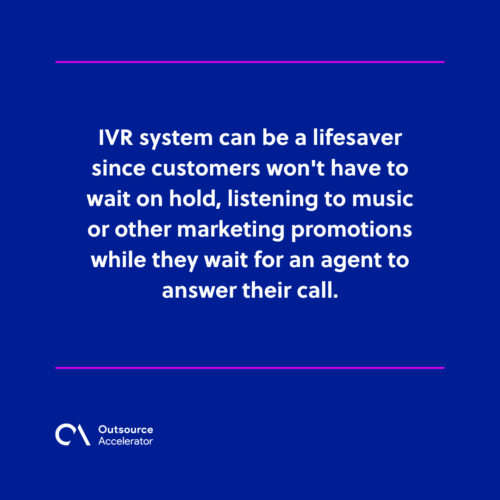6 ways to effectively manage high call volume

High call volume is a direct result of increased demand. Many businesses face this challenge, especially as customer expectations[1] are on the rise.
While it’s true that most sales are made without many back-and-forth questions, there will be instances where someone just needs to talk about the problem.
As call volume increases, phone systems can be difficult to manage. This can negatively impact customer experience[2] and even create costly company issues.
Whether how your customers are getting in touch, you need effective ways to manage the ever-increasing communication that comes from running an organization.
Read this article to learn how to manage high call volumes better.
What is call volume?
Call volume typically refers to the number of phone calls or other forms of communication a business receives within a specific period.
This is an important metric for customer service teams to track and manage workload, allocate resources, and improve service levels.
In telecommunications, call volume is the amount of traffic carried over by a network or a particular phone line. It is usually measured in terms of the number of calls per unit of time.

For instance, a phone system might be designed to handle 100 simultaneous calls, which means it has a call volume capacity of 100. If the number of incoming calls exceeds the system’s call volume capacity, callers may experience long wait times.
In this sense, call volume is an important consideration for businesses and organizations that rely heavily on phone communications. They must ensure their phone systems can handle their expected call traffic.
What causes high call volume?
Call volumes can fluctuate significantly from month to month, and it can be caused by a variety of factors, including:
- Seasonal or periodic spikes in call traffic. Typically, holiday periods or peak sales seasons may generate a higher volume of calls. Customers may seek information about products or services, place orders, or inquire.
- Technical or system issues. Issues with a company’s website, product, or service may prompt customers to call for support, increasing call volume.
- Poor software integration. Using multiple chat tools that aren’t integrated can lead to confusion among agents and customers alike when they try to reach out for support.
- Marketing and promotional campaigns. A successful marketing or promotional campaign may generate many inquiries, orders, or calls.
- Limited customer service options. A company’s limited customer service options may result in a higher volume of calls as customers have no other means to reach the company.
High call volumes are not only frustrating for businesses — they also affect customers. In fact, a Salesforce survey revealed that 44% of customers report being irritated or annoyed when kept on hold for 5 to 15 minutes.
Managing calls effectively is critical for companies with large customer bases or frequent customer interactions.

Ways to effectively manage high call volume
It’s important to plan and ensure your employees are prepared with the right tools they need to handle the influx of calls.
Here are some ways to efficiently handle high call volume:
Leverage automation for your team’s workflow
Automation can be a great way to streamline your team members’ workflows, but it can also be used to help manage the high call volume that comes with peak hours.
The right tools allow you to automate customer support processes like creating and sending emails, assigning cases, and sending notifications. These tools might reduce the time your team takes to respond to customers by automating repetitive tasks.
Provide self-service resources
Many people prefer to resolve their own issues rather than call customer support.
If you provide them with helpful self-service resources, they’ll be more likely to find answers independently — thus reducing your call volume. This includes services such as FAQs, videos, and tutorials.
If something keeps coming up in customer calls or emails, creating a video on the topic might be good so people don’t have to ask about it repeatedly.
Some customers may prefer this method because it allows them to complete tasks conveniently and in their own time.
Analyze your contact center metrics
The best way to understand why your calls are coming in so fast is to analyze your contact center metrics and review historical data. Contact centers rely on metrics for optimal performance and efficiency.
You should be able to see if there are any trends or patterns that can help you predict future call volumes and prepare for them accordingly.
By analyzing the metrics of your contact center, you can determine whether it needs to be reorganized or if other issues should be addressed.
Offer a call-back option
If you cannot answer all calls due to high call volume, let the caller know they can leave a voicemail or send a text message with their issue to be addressed later.
This allows customers who don’t need immediate assistance to leave their information and be called back when the queue is shorter.
Call back-option allows you to review previous cases before speaking with the customer again, eliminate redundancy, and ensure you provide better service overall.
Open additional customer service channels
Another great way to reduce your call volume is to open additional customer service channels. This could be through social media or a contact form on your website that allows customers to contact you in ways other than by phone.
You could try opening an email address or live chat channel for customers who need help but don’t want to wait on hold. It can help reduce the number of calls you receive and keep your customers happier since they don’t have to sit on hold for long periods.
All these options will mean that calls aren’t being missed and allow for greater efficiency for both parties involved.
Optimize your IVR
Your IVR should accommodate high call volumes without crashing or breaking down under heavy traffic. This can be done using an automated system that detects traffic spikes and adapts accordingly.
Essentially, this ensures that all calls are answered quickly, which helps reduce customer wait time and improves customer satisfaction levels.
You can also optimize your IVR by adding extra prompts for specific scenarios, such as when a call queue or the agent is busy with other calls.
IVR system can be a lifesaver since customers won’t have to wait on hold, listening to music or other marketing promotions while they wait for an agent to answer their call.

Take control of your call volume and improve customer support
Customer support can become overwhelming due to the number of calls. It can be daunting, especially when dealing with unexpected spikes in call volume.
This is a challenging problem for many businesses. It can be difficult to manage and will always get worse before it gets better.
You can easily manage a high call volume by implementing effective ways to help your team answer calls more quickly and efficiently.
With stringent call volume strategies in place, you can enrich your customer satisfaction and double up your bottom line.
Article References:
[1] Customer expectations. Wali, A.F. and Nwokah, N.G. (2018). Understanding customers’ expectations for delivering satisfactory and competitive services experience. International Journal of Electronic Marketing and Retailing, 9(3), p.254.







 Independent
Independent




